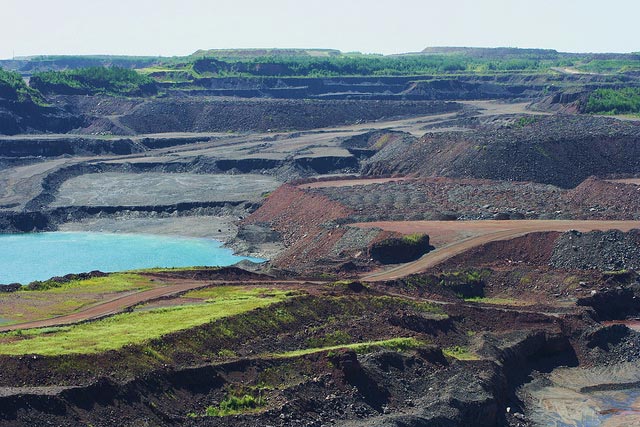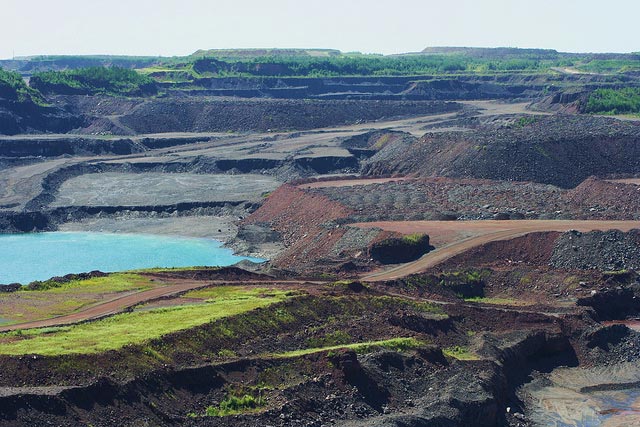
 A portion of the Hull-Rust Mahoning mine in Hibbing, Minnesota, a 1.5 mile long open-pit iron mine. Minnesota is considering sulfide mining as a potential investment. Sulfide mines are notorious for producing highly toxic contaminants that easily leach into waterways. (Photo: Lars Hammar / Flickr)
A portion of the Hull-Rust Mahoning mine in Hibbing, Minnesota, a 1.5 mile long open-pit iron mine. Minnesota is considering sulfide mining as a potential investment. Sulfide mines are notorious for producing highly toxic contaminants that easily leach into waterways. (Photo: Lars Hammar / Flickr)
Over the last century, Minnesota’s “Iron Range” has produced billions of tons of iron ore, as well as its less pure counterpart taconite, both key ingredients for US steel manufacturing. Iron mining successfully bolsters the state economy and supports a large, unionized labor force.
Now, as the profitability of Minnesota iron is squeezed by a global oversupply and international competition, the state is looking into sulfide mining as a potential investment for the future. Thousands of critics, however, have registered concerns about the potential environmental impact of the proposed mines. Sulfide mines are notorious for producing highly toxic contaminants that easily leach into waterways.
Sulfide mining separates metals like gold, platinum, copper and nickel from ores containing sulfur. The minerals are used primarily to create wiring and electronics for everything from power plants to cellphones.
Minnesota has some of the largest deposits of copper and nickel in the world, according to Mining Minnesota, an advocacy group made up of lobbyists and industry leaders dedicated to promoting precious metal mining. The group is pushing hard for sulfide mining in Minnesota. Its website states: “Minnesota has a history of getting things right. Responsible copper and nickel mining is next on our list.”
But Al Gedicks, environmental sociologist at the University of Wisconsin, La Crosse, is not convinced that sulfide mining is a responsible economic decision for the state. “There is no demand for either copper or nickel or any of the other metals that would be extracted from the [Minnesota] deposit,” Gedicks told Truthout. In the past five years, both copper and nickel prices have dropped dramatically.
Bruce Richard, vice president of corporate communications and external affairs for PolyMet Mining Corporation, says proposed mines would still meet an international need. He wrote in an email to Truthout, “Worldwide inventories at the current time are not in balance with demand, but that’s the cyclical nature of the industry, where supply and demand ebbs and flows. Overall, demand for copper continues to grow worldwide.”
PolyMet Mining Corporation is set to build the first sulfide mine in northern Minnesota. The proposed mine, known as NorthMet mine, will span three open pits. A refurbished iron processing plant will perform new techniques that allow the extraction of copper and nickel from Minnesota’s low-quality deposits.
While the Canadian-based PolyMet Corporation is new to mining, 33.8 percent of the company’s voting rights are owned by Swiss commodity trading giant Glencore International, which has a long history in the international mining industry. In recent years, the Fortune 500 company has been criticized for unethical practices while promoting its interests around the globe.
Despite state tradition and economic incentive, 58,000 people raised concerns over the proposed mining project.
Traditionally, Minnesotans are pro-mining. Mining in northern Minnesota provides jobs to thousands of union workers at an average annual salary of $100,000, according to the Iron Mining Association of Minnesota. A percentage of taxes levied on iron mining goes toward public schools and universities. Even some of Minnesota’s conservation projects are funded by tax revenue from iron mining. Recent layoffs in the iron mines have devastated towns in northern Minnesota.
Despite state tradition, economic incentive and an unstable job climate, 58,000 people raised concerns over the proposed NorthMet mining project during the 90-day public comment period on the 2013 environmental impact statement.
The environmental group, Friends of the Boundary Waters, argues on its website that sulfide mining in the Iron Range will cause local lakes and rivers to become polluted. St. Louis County, where NorthMet mine will be located, is home to major tourist attractions and wilderness reserves, including Superior National Forest, Lake Superior and the Boundary Waters Canoe Area.
In its final environmental impact statement, PolyMet predicted that NorthMet’s containment system would “achieve complete capture of groundwater” close to the surface. This water will be treated and discharged, eventually flowing into Lake Superior. Their model shows the mine will meet state water quality standards.
However, a study of 25 sulfide mines by environmental consulting groups Kuipers & Associates and Buka Environmental found that 60 percent of sulfide mines exceeded state water quality standards, and in only 4 percent of project plans was water quality impact correctly predicted.
Tom Myers, an independent consultant with a Ph.D. in hydrology from the University of Nevada, prepared a report for the Minnesota Center for Environmental Advocacy that claims “the analyses of the [NorthMet] containment system rely on grossly optimistic assumptions.”
In general, sulfide mining is more environmentally risky than iron mining. The process produces significant quantities of both sulfates and mercury, which, when combined, create the highly toxic substance methylmercury. This mercury accumulates to toxic levels as it moves up through the food chain, eventually posing a direct threat to humans. Past mercury contamination has led to fishing bans throughout Minnesota.
The Boundary Waters Canoe Area Wilderness has been protected since 1978 and attracts 250,000 tourists annually, many of whom are avid fishermen. While the Boundary Waters is in a different watershed than the NorthMet mine, Myers predicted that other mining activities in the area could cause contaminants from NorthMet to bridge the divide between watersheds and flow north toward the Boundary Waters.
PolyMet pledged its commitment for the protected areas in its “Water Quality Fact Sheet,” which takes special note of the concerns over possible contamination of the Boundary Waters. It states: “The PolyMet project is in the Lake Superior watershed so none of the treated water that will be discharged from the site will ever enter the Boundary Water Canoe Area Wilderness lakes or streams. PolyMet’s commitment to protecting water quality and complying with all applicable water quality standards remains steadfast regardless of the watershed.”
The Downstream Business Coalition, a group of 69 local businesses considered to be “pro-responsible mining,” opposes the NorthMet mine on environmental and economic grounds. In an open letter to Minnesota Gov. Mark Dayton, the group stated: “We believe the risk to the environment poses a long-term threat to the regional economy that far outweighs the short-term benefits.”
PolyMet’s project proposal assumes that the mine will create 360 jobs directly and 600 more indirectly – a total of 960 possible jobs. According to an independent study done by the University of Minnesota Duluth Labovitz School of Business and Economics, mining output, or sales, will generate around $515 million annually.
In contrast, tourism in St. Louis County alone generates a half billion dollars in gross sales and another $33 million for the state government in sales taxes. Minnesota’s tourism industry generates thousands of jobs and has grown significantly in recent years.
“If you are going to invest state resources into generating jobs, then you get much more ‘bang for the buck’ by investing in tourism, recreation and sustainable agriculture and forestry, than you would by investing in a mining project,” the University of Wisconsin’s Gedicks told Truthout.
Beyond its potential effect on tourism revenue in the state, the NorthMet mine threatens wetlands in the area. Wetlands filter and regulate water flow and are one of the most productive ecosystems on the planet, equal to the tropical rain forest and coral reefs.
According to its impact statement, the NorthMet mine is predicted to directly disturb almost 12.5 square miles of wetlands. By law, any wetland that has been harmed by the mining project must be replaced. Replacement systems often fall short, however. There are eight types of wetlands and each has a different function. Replacing wetlands of a different type or in a different watershed is less effective than protecting the original wetlands.
Paul Glaser, a research professor with the University of Minnesota’s Earth Science Department, wrote that the wetland replacement sites chosen by PolyMet are “inadequate for fulfilling mitigation needs since these mitigation sites are located in an entirely different drainage basin and also contain wetlands that are quite different from those at the NorthMet site.”
Additionally, the simulated water models for the NorthMet mine did not take into account the water passing between wetlands and groundwater. This interaction could cause wetland water levels to drop and toxin levels to rise, increasing wetland destruction.
“This is a failure to disclose potential impacts of the projects, including water quality impacts to wetlands. These are impacts that, if severe enough, could cause substantial mitigation to be required, including denial of the permit,” Myers wrote in his report.
Noting the deficiency in PolyMet’s wetlands plan, the US Environmental Protection Agency (EPA) recommended that the US Army Corp of Engineers require PolyMet to monitor wetland impacts, develop an impact assessment and create a contingency plan.
Still, the EPA approved the final environmental impact statement for the NorthMet mine on December 21, 2015. Now, the Minnesota Department of Natural Resources must approve the impact statement before the project can move on to permitting.
The official decision is expected in February, although Department of Natural Resources Commissioner Tom Landwehr already said he plans to approve it. This decision will come amid an EPA investigation into allegations that the Minnesota Pollution Control Agency failed to hold iron mining companies to the standards set by the Clean Water Act.
The NorthMet mine is not the only sulfide mine proposed in northern Minnesota. Twin Metals is about two years away from submitting their environmental impact statement for a mine to be located near the NorthMet site. The Twin Metals mine would fall within the Boundary Waters Canoe Area watershed. Any spill or leak from the Twin Metals mine would cause the Boundary Waters to become polluted with no feasible cleanup option.
Join us in defending the truth before it’s too late
The future of independent journalism is uncertain, and the consequences of losing it are too grave to ignore. To ensure Truthout remains safe, strong, and free, we need to raise $46,000 in the next 7 days. Every dollar raised goes directly toward the costs of producing news you can trust.
Please give what you can — because by supporting us with a tax-deductible donation, you’re not just preserving a source of news, you’re helping to safeguard what’s left of our democracy.